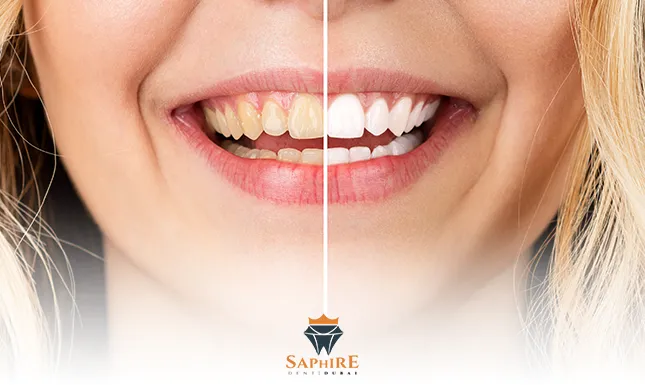Dental Aesthetics: Your Charming Smile Within Reach
It is always good to smile confidently, but have you ever felt unwilling to smile because of dental issues?
Dental aesthetics is the solution that can restore your confidence and improve the beauty and health of your teeth.
In this article, we will learn about various types of dental aesthetic procedures, their benefits, and the necessary post-procedure care. So, keep reading for more knowledge.
What is Dental Aesthetics?
Dental aesthetics is a set of medical procedures aimed to improve the appearance and function of the teeth.
Types of Dental Aesthetic Procedures:
Dental aesthetic procedures include several important actions:

Porcelain Veneers:
Also known as the “Hollywood smile,” it is one of the famous and advanced methods of dental aesthetics, especially for the front teeth.
This type of aesthetics involves using thin pieces of porcelain carefully fitted to the tooth surface to significantly change its shape and color.
The “Hollywood smile” aims to give teeth an aesthetically pleasing and attractive appearance similar to those of many Hollywood celebrities, with the veneer color carefully selected to match the natural whiteness of the teeth and achieve the desired result.
Porcelain veneers fixed to the front and sometimes side teeth, and the shape of the teeth can be adjusted to better harmonize with the mouth structure and facial features.
Enhancing the “Hollywood smile” boosts the beauty of the smile and gives the person extra confidence in their personal appearance.

Teeth Whitening
Teeth whitening is one of the most common and effective procedures in dental aesthetics.
Whitening can be done at home or in the clinic using special whitening agents.

orthodontics
Orthodontic procedures help correct issues of teeth crowding and spacing.
The position of the teeth is corrected using braces and medical devices.

Dental Implants
Dental implants are an effective solution for replacing missing teeth.
Artificial teeth are placed in the missing tooth’s location, restoring the natural function and aesthetic appearance of the mouth.
It is important to follow the doctor’s instructions post-procedure to maintain good results.

Who Can Greatly Benefit from Dental Aesthetic Procedures?
Dental aesthetics is preferred for individuals with severe discoloration, crowded teeth, or complete tooth loss.
The patient should generally be in good health and have realistic expectations from the procedure.
Post-Dental Aesthetic Procedure Care Steps:
After undergoing a dental aesthetic procedure, it is important to follow necessary oral care instructions to maintain beautiful and healthy results for a long time.
1. Maintaining Good Oral Hygiene
After aesthetics, you should maintain dental cleanliness with regular brushing, flossing, and mouth rinsing. This helps prevent bacterial buildup and maintain gum health.
2. Following a Healthy Diet
It is recommended to eat healthy and nutritious foods that help promote dental and gum health, such as fruits, vegetables, and low-fat dairy.
3. Avoiding Harmful Habits
Avoid habits like nail-biting or opening packages with your teeth, as these can affect the treatment results and damage the teeth.
4. Regular Check-Up Visits
Regular visits to the dentist for examination and assessment of the teeth’s condition are important, as they help
Frequently Asked Questions About Dental Aesthetics:
Color: If your teeth are noticeably yellow, dark, or stained, dental aesthetics might be a good option for you.
Shape: If your teeth are cracked, broken, or unevenly shaped, dental aesthetics can help improve their appearance.
Position: If your teeth are crooked or misaligned, orthodontics or other aesthetic treatments can help to fix them.
Gaps: If you have gaps between your teeth so bridges or dental implants can help fill them.
Gum Health: If you have gum disease, you may need to treat it before undergoing any aesthetic procedures.
There are some alternatives to dental aesthetics, such as:
Over-the-counter teeth whitening products: These can help lighten your teeth a bit, but may not be as effective as professional dental aesthetic treatments.
Temporary dental veneers: These veneers are made from plastic or resin materials and can be applied to the teeth temporarily to improve their appearance.
Metal dental restorations: These restorations are more durable than porcelain veneers, but they may not look as natural.
It depends on the type of treatment. Some dental aesthetic treatments, like teeth whitening, do not require any anesthesia.
Other treatments, such as fitting veneers or dental implants, may require local anesthesia.
In general, dentists aim to make the dental aesthetic experience as comfortable as possible.
Recovery time after dental aesthetics varies depending on the type of treatment.
In general, recovery time is short.
For example, you might feel some discomfort after teeth whitening, but it should subside within a day or two.
Other treatments, such as fitting veneers or dental implants, may take a week or two to recover.
Your dentist will provide specific post-care instructions after a dental aesthetic procedure.
It is important to follow these instructions to help speed up the healing process and prevent any complications.
Dental aesthetics represents an investment in the health and beauty of your teeth and smile.
Turning to aesthetic procedures helps you achieve a beautiful smile that reflects your confidence and enhances your personal attractiveness.


